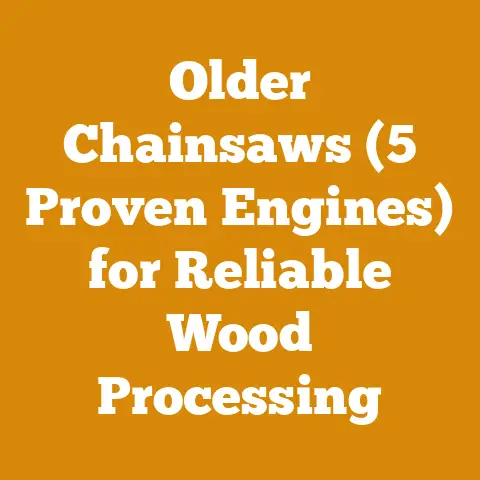Remanufactured Chainsaws for Firewood Cutting (5 Pro Tips)
Remanufactured Chainsaws for Firewood Cutting: 5 Pro Tips to Save Money and Cut Like a Pro
Let’s face it: a brand-new, top-of-the-line chainsaw can be a significant investment, especially if you’re primarily using it for seasonal firewood cutting. While a shiny new saw is tempting, a well-chosen, remanufactured chainsaw can be a fantastic alternative, offering significant savings without sacrificing performance. It’s like finding a diamond in the rough – a tool that’s already proven its mettle and is ready to tackle your woodpile. And if you are looking for low-maintenance options, consider electric chainsaws.
Key Takeaways: In this article, I’ll share my top 5 pro tips for selecting and using remanufactured chainsaws for firewood cutting. You’ll learn how to:
- Assess the Remanufacturing Quality: Understand what to look for to ensure you’re getting a reliable saw.
- Match the Saw to Your Needs: Choose the right size and power for your typical firewood tasks.
- Master Essential Maintenance: Keep your remanufactured saw running smoothly with simple upkeep.
- Employ Safe Cutting Techniques: Maximize efficiency and minimize risk while cutting.
- Troubleshoot Common Issues: Learn how to diagnose and fix minor problems yourself.
My Journey with Chainsaws: From Newbie to Seasoned Woodcutter
I still remember the first time I picked up a chainsaw. It was a hand-me-down from my grandfather, a burly old Stihl that had seen better days. The thing weighed a ton, vibrated like a jackhammer, and started only when it felt like it. But it was my gateway into the world of woodcutting.
Over the years, I’ve used all kinds of chainsaws – from small electric models for trimming to professional-grade saws for felling trees. I’ve learned a lot about what makes a good chainsaw, how to maintain them, and how to use them safely and efficiently. And, importantly, I’ve learned that you don’t always need to break the bank to get a reliable tool.
I’ve seen firsthand the value of a well-maintained, remanufactured chainsaw. In fact, for several years, my primary firewood saw was a remanufactured Husqvarna that I picked up for a fraction of the cost of a new one. It was a workhorse, and with proper care, it served me faithfully for years. This experience is what drives my belief that remanufactured chainsaws are an excellent option for budget-conscious woodcutters.
Why Choose a Remanufactured Chainsaw?
The primary appeal of a remanufactured chainsaw is cost savings. You can often find a quality remanufactured saw for 30-60% less than the price of a new model. This can free up your budget for other essential tools and safety equipment.
Beyond the price tag, there are other benefits:
- Reduced Environmental Impact: Buying remanufactured helps reduce waste and the demand for new resources.
- Proven Reliability: A remanufactured saw has already been tested and, ideally, had any weak points addressed.
- Potential for Higher-End Models: You might be able to afford a higher-end model in remanufactured condition that would be out of reach brand new.
However, it’s crucial to approach the purchase of a remanufactured chainsaw with caution and do your homework. Not all remanufactured saws are created equal.
1. Assessing the Remanufacturing Quality: What to Look For
This is where the rubber meets the road. A poorly remanufactured chainsaw can be a money pit, constantly needing repairs and ultimately costing you more in the long run. Here’s what I look for:
Reputable Seller:
- Warranty: A solid warranty (at least 30 days, ideally longer) is a must. It shows the seller stands behind their work.
- Return Policy: Understand the return policy in case the saw doesn’t meet your expectations.
- Customer Reviews: Check online reviews of the seller to gauge their reputation and customer service.
- Certifications: Some remanufacturers are certified by organizations that ensure quality standards. Look for these certifications if possible.
Detailed Inspection Checklist:
A reputable seller should provide a detailed list of the work that was done during the remanufacturing process. This should include:
- Engine Condition:
- Compression Test: A compression test measures the pressure inside the cylinder, indicating the health of the piston rings and cylinder walls. Ask for the compression reading. A healthy reading is typically above 100 PSI (pounds per square inch), but varies depending on the specific model.
- Cylinder Scoring: Check for scratches or scoring on the cylinder walls, which can indicate engine wear.
- Piston Condition: Inspect the piston for wear, cracks, or carbon buildup.
- Fuel System:
- Carburetor Cleaning/Rebuild: The carburetor mixes fuel and air, and it’s a common source of problems in older chainsaws. Ask if the carburetor has been cleaned or rebuilt.
- Fuel Lines: Check the fuel lines for cracks or leaks.
- Fuel Filter: The fuel filter prevents debris from entering the carburetor. It should be replaced during remanufacturing.
- Ignition System:
- Spark Plug: The spark plug ignites the fuel-air mixture. It should be replaced with a new one.
- Ignition Coil: The ignition coil provides the high-voltage spark. Check for cracks or damage.
- Oiling System:
- Oil Pump: The oil pump lubricates the chain. Ensure it’s functioning properly.
- Oil Lines: Check the oil lines for leaks.
- Oil Filter: The oil filter prevents debris from entering the oil pump. It should be cleaned or replaced.
- Chain and Bar:
- Chain Sharpness: The chain should be sharp and properly tensioned.
- Bar Condition: The bar should be straight and have a clean groove.
- Sprocket Condition: The sprocket drives the chain. Check for wear or damage.
- Safety Features:
- Chain Brake: The chain brake is a crucial safety feature that stops the chain in case of kickback. Ensure it’s functioning properly.
- Throttle Lock: The throttle lock prevents accidental acceleration. Ensure it’s working correctly.
- Chain Catcher: The chain catcher prevents the chain from flying back towards the operator in case of a chain break.
Pro Tip: Don’t be afraid to ask questions! A reputable seller should be happy to answer your questions and provide detailed information about the remanufacturing process. If they are evasive or unwilling to provide information, that’s a red flag.
Example: I once purchased a remanufactured chainsaw from a seller who claimed to have “thoroughly inspected” it. When I received the saw, the chain was dull, the carburetor was clogged, and the chain brake was broken. It was clear that the seller had not done a proper job. I immediately returned the saw and got my money back. This experience taught me the importance of doing my due diligence and buying from a reputable seller.
Visual Inspection:
Even with a detailed checklist, a visual inspection is essential. Look for:
- Cleanliness: A clean saw is a good sign that the remanufacturer took pride in their work.
- Missing or Damaged Parts: Check for any missing or damaged parts, such as screws, bolts, or covers.
- Signs of Wear: Look for excessive wear on the bar, chain, or sprocket.
- Leaks: Check for fuel or oil leaks.
Starting and Running:
If possible, start the saw and let it run for a few minutes. Listen for any unusual noises, such as knocking, rattling, or squealing. The saw should idle smoothly and accelerate quickly when you squeeze the throttle.
Pro Tip: If you’re not comfortable starting and running the saw yourself, ask the seller to demonstrate it for you.
2. Matching the Saw to Your Needs: Size and Power Matter
Choosing the right size and power for your firewood cutting needs is crucial. A saw that’s too small will struggle to cut through larger logs, while a saw that’s too large will be unwieldy and tiring to use.
Bar Length:
The bar length determines the maximum diameter of the logs you can cut. As a general rule:
- 14-16 inches: Suitable for small to medium-sized firewood.
- 18-20 inches: Good for medium to large-sized firewood.
- 20+ inches: For very large logs and felling trees.
I find that an 18-inch bar is a good all-around choice for most firewood cutting tasks. It’s long enough to handle most logs, but not so long that it becomes difficult to maneuver.
Pro Tip: When in doubt, err on the side of a slightly longer bar. It’s better to have too much bar than not enough.
Engine Size (CCs):
The engine size determines the power of the saw. A larger engine will have more power and be able to cut through wood faster.
- 30-40 CCs: Suitable for light-duty tasks, such as pruning and limbing.
- 40-50 CCs: Good for medium-duty firewood cutting.
- 50+ CCs: For heavy-duty firewood cutting and felling trees.
For most firewood cutting, I recommend a saw with an engine size of 40-50 CCs. This will provide enough power to cut through most types of wood without being too heavy or difficult to handle.
Type of Wood:
The type of wood you’ll be cutting also affects the size and power of the saw you need. Hardwoods like oak and maple require more power than softwoods like pine and fir. If you’re primarily cutting hardwoods, you’ll want to choose a saw with a larger engine and a longer bar.
Data Point: Research from the Forest Products Laboratory shows that the specific gravity (a measure of density) of oak is nearly twice that of pine. This means oak requires significantly more force to cut.
Your Physical Strength and Stamina:
Don’t underestimate the importance of your physical strength and stamina. A chainsaw can be heavy and tiring to use, especially for extended periods. Choose a saw that you can comfortably handle without getting fatigued too quickly.
Pro Tip: If you’re not sure which size and power saw is right for you, try renting a few different models and see which one you like best.
3. Mastering Essential Maintenance: Keeping Your Saw Running Smoothly
Proper maintenance is crucial for keeping your remanufactured chainsaw running smoothly and extending its lifespan. Here are some essential maintenance tasks:
Chain Sharpening:
A sharp chain is essential for efficient and safe cutting. A dull chain will require more force to cut through wood, which can lead to fatigue and increase the risk of kickback.
- Frequency: Sharpen the chain every few hours of use, or whenever it starts to feel dull.
- Tools: You’ll need a chainsaw file, a file guide, and a depth gauge.
- Technique: Follow the manufacturer’s instructions for sharpening the chain. Be sure to maintain the correct filing angle and depth.
Step-by-Step Guide to Chain Sharpening:
- Secure the Saw: Place the chainsaw on a stable surface and engage the chain brake.
- Use a File Guide: Place the file guide on the chain, aligning it with the cutting tooth.
- File the Cutting Tooth: Use the chainsaw file to sharpen the cutting tooth, following the angle and depth specified in the manufacturer’s instructions.
- Repeat for All Teeth: Repeat the process for all the cutting teeth on the chain.
- Adjust Depth Gauges: Use the depth gauge to adjust the height of the depth gauges, which control the amount of wood the chain takes with each cut.
Pro Tip: Consider investing in a chainsaw chain sharpener. These tools can make chain sharpening faster and easier, and they can help you maintain a consistent sharpening angle.
Chain Tensioning:
Proper chain tension is also essential for safe and efficient cutting. A chain that’s too loose can derail, while a chain that’s too tight can overheat and break.
- Frequency: Check the chain tension before each use and adjust as needed.
- Technique: Loosen the bar nuts and use the chain tensioning screw to adjust the chain tension. The chain should be snug against the bar but still able to be pulled around by hand.
Step-by-Step Guide to Chain Tensioning:
- Loosen the Bar Nuts: Use a wrench to loosen the bar nuts, but don’t remove them completely.
- Adjust the Tensioning Screw: Locate the chain tensioning screw, which is usually located on the side of the chainsaw. Use a screwdriver to turn the tensioning screw, tightening or loosening the chain as needed.
- Check the Tension: The chain should be snug against the bar, but you should still be able to pull it around by hand.
- Tighten the Bar Nuts: Once you’ve adjusted the chain tension, tighten the bar nuts securely.
Bar Maintenance:
The chainsaw bar also requires regular maintenance.
- Cleaning: Clean the bar regularly with a wire brush to remove sawdust and debris.
- Filing: File the bar rails to remove any burrs or damage.
- Oiling: Ensure the bar is properly lubricated with chainsaw bar oil.
Air Filter Cleaning:
A dirty air filter can restrict airflow to the engine, reducing power and increasing fuel consumption.
- Frequency: Clean the air filter every few hours of use, or more often if you’re cutting in dusty conditions.
- Technique: Remove the air filter and clean it with compressed air or warm, soapy water.
Fuel and Oil:
- Fuel: Use fresh, high-quality gasoline with the correct octane rating. Mix the fuel with the correct amount of two-stroke oil, as specified by the manufacturer.
- Oil: Use chainsaw bar oil to lubricate the chain and bar.
Pro Tip: Store your chainsaw in a dry place when not in use. This will help prevent rust and corrosion.
4. Employing Safe Cutting Techniques: Maximize Efficiency and Minimize Risk
Safety should always be your top priority when using a chainsaw. Here are some essential safety tips:
Personal Protective Equipment (PPE):
Always wear the following PPE when using a chainsaw:
- Chainsaw Helmet: Protects your head from falling debris.
- Eye Protection: Protects your eyes from flying chips and sawdust.
- Hearing Protection: Protects your ears from the loud noise of the chainsaw.
- Chainsaw Gloves: Provide a good grip and protect your hands from cuts.
- Chainsaw Chaps: Protect your legs from accidental cuts.
- Steel-Toed Boots: Protect your feet from falling logs and other hazards.
Safe Cutting Practices:
- Plan Your Cuts: Before you start cutting, plan your cuts and make sure you have a clear escape route.
- Maintain a Firm Stance: Keep your feet firmly planted on the ground and maintain a balanced stance.
- Use Both Hands: Always use both hands to operate the chainsaw.
- Avoid Kickback: Kickback is a sudden, uncontrolled movement of the chainsaw that can cause serious injury. Be aware of the risk of kickback and take steps to avoid it.
- Don’t Overreach: Don’t overreach or cut above your head.
- Take Breaks: Take frequent breaks to avoid fatigue.
- Work in a Clear Area: Clear the area around you of any obstacles, such as rocks, branches, or debris.
- Be Aware of Your Surroundings: Be aware of your surroundings and watch out for other people, animals, or hazards.
Pro Tip: Take a chainsaw safety course. These courses will teach you how to use a chainsaw safely and efficiently.
Cutting Techniques for Firewood:
- Bucking: Bucking is the process of cutting logs into shorter lengths for firewood.
- Limbing: Limbing is the process of removing branches from a felled tree.
- Splitting: Splitting is the process of splitting logs into smaller pieces for firewood.
Detailed Explanation of Bucking Techniques:
- Support the Log: Place the log on a stable surface, such as a log pile or a sawbuck.
- Make a Notch Cut: Make a notch cut on the underside of the log, about one-third of the way through.
- Make a Back Cut: Make a back cut on the top side of the log, slightly above the notch cut.
- Complete the Cut: Continue the back cut until it meets the notch cut, severing the log.
Case Study: A study by the National Institute for Occupational Safety and Health (NIOSH) found that the majority of chainsaw injuries occur during bucking and limbing operations. This highlights the importance of using proper cutting techniques and wearing appropriate PPE.
5. Troubleshooting Common Issues: Diagnosing and Fixing Problems Yourself
Even with proper maintenance, your remanufactured chainsaw may experience occasional problems. Here are some common issues and how to troubleshoot them:
Chainsaw Won’t Start:
- Check the Fuel: Make sure there’s fuel in the tank and that it’s fresh.
- Check the Spark Plug: Remove the spark plug and check for fouling or damage. Clean or replace the spark plug as needed.
- Check the Air Filter: Clean the air filter.
- Check the Carburetor: The carburetor may be clogged. Try cleaning the carburetor or rebuilding it.
Chainsaw Runs Poorly:
- Check the Fuel: Make sure the fuel is fresh and mixed correctly.
- Check the Air Filter: Clean the air filter.
- Check the Spark Plug: Clean or replace the spark plug.
- Adjust the Carburetor: The carburetor may need to be adjusted. Consult the owner’s manual for instructions.
Chainsaw Chain Won’t Oil:
- Check the Oil Level: Make sure there’s oil in the oil tank.
- Check the Oil Filter: Clean the oil filter.
- Check the Oil Pump: The oil pump may be clogged or damaged.
Chainsaw Chain Keeps Derailing:
- Check the Chain Tension: Adjust the chain tension.
- Check the Bar: The bar may be worn or damaged.
- Check the Sprocket: The sprocket may be worn or damaged.
Pro Tip: Keep a basic toolkit on hand for troubleshooting and repairing your chainsaw. This should include a screwdriver, wrench, pliers, spark plug wrench, and chain file.
Actionable Conclusions:
Choosing a remanufactured chainsaw can be a smart, economical way to tackle your firewood cutting needs. By following these pro tips, you can find a reliable saw, keep it running smoothly, and cut wood safely and efficiently. Remember to prioritize safety, perform regular maintenance, and don’t be afraid to ask for help when you need it. Now, get out there and start cutting!






